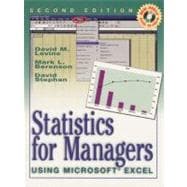
What is included with this book?
Case Study A: Alumni Association Survey. Supplement Using Microsoft Excel for Statistical Analysis.
The Springville Herald Case. 3. Summarizing and Describing Numerical Data.
Case Study B: State Alcoholic Beverages Oversight Board Study on Beers.
Springville Herald Case. 4. Basic Probability and Discrete Probability Distributions.
Springville Herald Case. 5. Decision Making.
Springville Herald Case. 7. Confidence Interval Estimation.
Case Study C: Test Marketing and Promoting a Ball-Point Pen.
Springville Herald Case. 11. Two-Sample and c-Sample Tests with Categorical Data.
Case Study D: Airline Satisfaction Survey.
Springville Herald Case. 12. Statistical Applications in Quality and Productivity Management.
Case Study E: The Harnswell Sewing Machine Company.
Springville Herald Case. 13. The Simple Linear Regression Model and Correlation.
Case Study F: Predicting Sunday Newspaper Circulation.
Springville Herald Case. 14. Multiple Regression Models.
Case Study G: Predicting Moving Time at the EastWest Moving Company.
Case Study H: The Mountain States Potato Company. 15. Time-Series Analysis.
Case Study I: Currency Trading.
Springville Herald Case.
The New copy of this book will include any supplemental materials advertised. Please check the title of the book to determine if it should include any access cards, study guides, lab manuals, CDs, etc.
The Used, Rental and eBook copies of this book are not guaranteed to include any supplemental materials. Typically, only the book itself is included. This is true even if the title states it includes any access cards, study guides, lab manuals, CDs, etc.